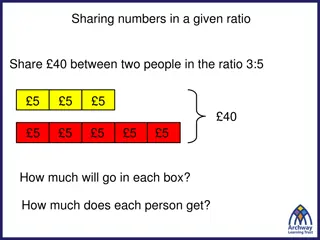Understanding and Comparing Ratios in Mathematics
In this lesson, students will learn how to compare ratios using different methods and make decisions based on the comparisons. Key vocabulary includes ratio, cross multiply, similar fractions, unit rate, and LCM. The lesson covers the comparison of ratios through methods like cross multiplication and changing ratios into similar fractions, providing sample problems for practical application.
Download Presentation

Please find below an Image/Link to download the presentation.
The content on the website is provided AS IS for your information and personal use only. It may not be sold, licensed, or shared on other websites without obtaining consent from the author. Download presentation by click this link. If you encounter any issues during the download, it is possible that the publisher has removed the file from their server.
E N D
Presentation Transcript
Comparing Ratios Unit 1 Lesson 4 Math 6
Comparing Ratios Students will be able to: Compare ratios using different methods. Make decisions by comparing ratios.
Comparing Ratios Key Vocabulary: Ratio Cross Multiply Similar Fractions Unit Rate LCM
Comparing Ratios Comparison of Ratios A ratio is a comparison of two quantities. To compare ratios is to determine whether the two given ratios are equal or not, and if one is greater or lesser than the other. This is very helpful in making decisions in real life situations. These comparisons can be obtained using different methods.
Comparing Ratios Method 1: COMPARING BY CROSS MULTIPLICATION Remember that ratios can be written as fractions, so one way to compare them is through the process of cross multiplying.
Comparing Ratios Method 1: COMPARING BY CROSS MULTIPLICATION Step 1: Rewrite the ratios into fractions. 3:4 4 2:3 3 3 2
Comparing Ratios Method 1: COMPARING BY CROSS MULTIPLICATION
Comparing Ratios Sample Problem 1: Compare the ratios 11:15 and 12:13 by cross multiplying. ?? ?? ?? ?? (15)(12) 180 Solution: 143 is less than 180, therefore 11:15 is less than 12:13 (11)(13) 143 <
Comparing Ratios Method 2: COMPARING BY CHANGING THE RATIOS INTO SIMILAR FRACTIONS Step 1: Rewrite the ratios into fractions. 3:4 4 2:3 3 3 2
Comparing Ratios Method 2: COMPARING BY CHANGING THE RATIOS INTO SIMILAR FRACTIONS
Comparing Ratios Method 2: COMPARING BY CHANGING THE RATIOS INTO SIMILAR FRACTIONS
Comparing Ratios Sample Problem 2: Compare the ratios 4:5 and 1:3 by changing them into similar fractions.
Comparing Ratios Method 3: COMPARING BY DETERMINING THE UNIT RATE Remember that unit rateis a rate where the second term of the ratio (or the denominator of a fraction) is equal to "1". Or to make it simpler, we get the quotient of the terms of a ratio (or the quotient of the numerator and denominator of a ratio expressed as a fraction).
Comparing Ratios Method 3: COMPARING BY DETERMINING THE UNIT RATE Step 1: Rewrite the ratios into fractions. 3:4 4 2:3 3 3 2
Comparing Ratios Method 3: COMPARING BY DETERMINING THE UNIT RATE Step 2: (Divide the numerator and the denominator of the fractions to make the denominator equal to 1. Find the unit rate of each ratio.
Comparing Ratios Method 3: COMPARING BY DETERMINING THE UNIT RATE Or we can just divide the terms directly. 3:4 2:3 3 4 = 0.75 2 3 = 0.67 0.75 is greater than 0.67, therefore 3:4 is greater than 2:3.
Comparing Ratios Sample Problem 3: Compare the ratios 4:3 and 7:5 by determining the unit rate.























